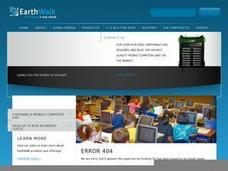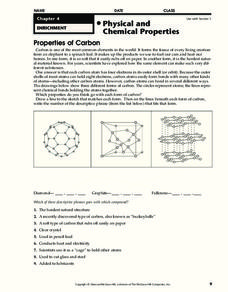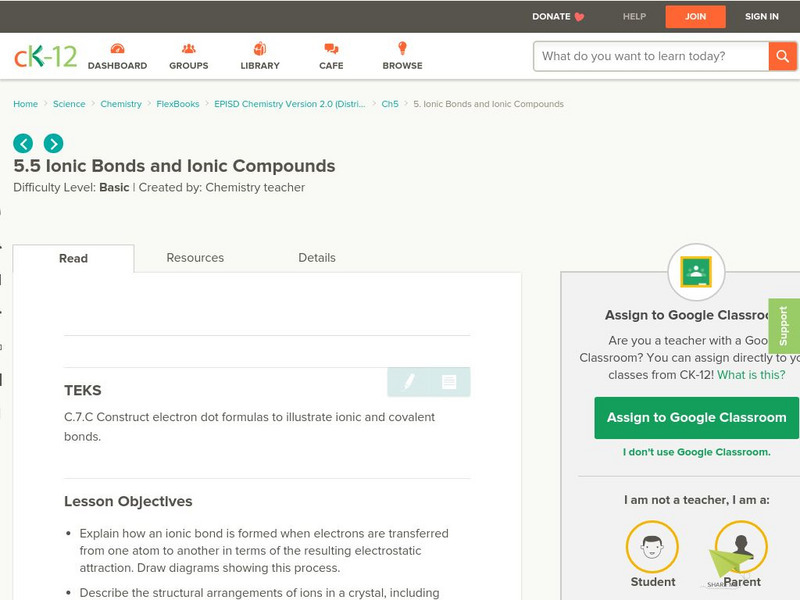Curated OER
Crystal Ice Art
This isn't just an art lesson, it's a science lesson too. Kids draw a lovely winter scene and then paint over it with a solution of epsom salts and water. They make predictions, then observe how crystals form as the water evaporates...
American Museum of Natural History
Grow Rock Candy
The best way to study crystals is to make your own! A hands-on lesson shows learners how to make their own rock candy from household materials. While they watch the crystals grow, they discover their structure and can even eat their...
Virginia Department of Education
Molecular Model Building
During this hands-on activity, young chemists build molecular models based on the Lewis dot structure before studying valence shell electron pair repulsion theory.
Curated OER
Watching Crystals Grow
Students observe crystal growth of Epsom salts and the variables that hinder or help their nucleation and growth. They illustrate a series of drawings/pictures as the crystals grow. They look for the different shapes they form as well...
Curated OER
Crystals: Geometry and Groups
Students discuss the importance of examining crystals and experiment growing them. In groups, they complete a project in which they use groups in geometry just like crystallographers. They practice solving the groups and proofs and...
Curated OER
Science Lessons for Grade 10
Tenth graders identify the parts and functions of the cell. In this series of science lessons, 10th graders investigate crystal formation in covalent compounds. They investigate the factors affecting reaction rates.
Curated OER
Chemical Bonding
In this chemical compounds worksheet, young scholars review the different types of bonding, define the octet rule, and draw Lewis structures (electron-dot diagrams) for given compounds. This worksheet has 7 fill in the blank, 5 short...
Curated OER
Solubility
In this solubility instructional activity, students determine which solute will be more soluble in the solvent listed. Students complete 7 matching and 3 problems to solve.
Curated OER
Science: Suddenly Snow
Students engage in snow-related activities during the first winter snowfall. After explaining the elements needed for it to snow, they preserve snowflakes on frozen slides and observe them under a microscope. Then, they write diamante...
Curated OER
Minerals
Students explore the concept of minerals. In this minerals instructional activity, students discuss how cooling affects the size of crystals. Students discuss how the structure of minerals is a tetrahedron. Students discuss the structure...
Curated OER
Pattern And Design in Nature
Students observe natural objects carefully and note intricate design and structure beyond surface form.
Curated OER
Minerals of the Earth
Students learn and practice identifying Earth's minerals and their properties. Working in small groups, they evaluate minerals. This is a well-described lesson, which students enjoy.
Curated OER
Ionic Nomenclature
One document contains five different worksheets for practice naming and writing formulas for ionic compounds. The first is particularly notable, as it systematically walks beginning chemists through the process of using the periodic...
Curated OER
Science Lessons
Tenth graders research about the different cell organelles. In this series of biology lessons, 10th graders compare two allotropes of carbon. They investigate how the rate of reaction is affected by concentration.
Curated OER
Physical and Chemical Properties
In this length activity, learners read about the properties of carbon. Students also decide which of the given phrases go with which compound.
CK-12 Foundation
Ck 12: Ionic Bonds and Ionic Compounds
[Free Registration/Login may be required to access all resource tools.] In the following online tutorial students will learn to explain how an ionic bond is formed when electrons are transferred from one atom to another in terms of the...

















